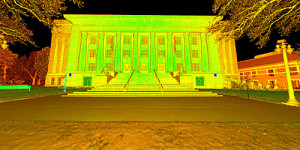At McNeil Engineering, we offer a wide selection of services, including laser scanning and building information modeling. This is a process by which our experts use lasers to capture accurate data from buildings, structures, masses of land and all other sorts of things and create an exact digital 3D model. This model can then be used to help plan projects, investigate structures, or just to preserve the image of whatever was scanned for future reference. We offer laser scanning services for any project one could think of that would benefit from it, some of which might be unexpected to those uninformed. If that’s the case for you, and you’re interested in learning more, here are 3 unexpected uses for laser scanning.
1. Forensic/insurance investigation
When an incident happens, sometimes it can be difficult for even the most skilled crime-scene photographer or police officer to accurately depict what the scene looks like. There’s an incredible amount of human error involved in crime scene data collection, especially when the scene is chaotic. This is understandable, but also unacceptable as it can often lead to mixed information given to the public or a jury if a jury is involved.
Let’s use a house fire as an example. If a house is burning down, after firefighters gain control and put out the flames, the scene can be incredibly dangerous for everyone involved. Generally, at some point, firefighters, police officers and/or insurance investigators have to re-enter the wreckage of the house and try to figure out how the fire was started to know how to accurately handle the situation. If this investigation happens even one day after the fire, environmental factors can severely change the scene. However, with laser scanning involved, after the fire is controlled, a laser scanning team can come in and scan the building from a safe distance and create an accurate 3D model of the building directly after the incident, which can then be studied by experts without worry that it will be changed by environmental factors or vandalized.
Laser scanning can be helpful in all sorts of investigations whether it be a car crash or a traditional crime scene. Having an accurate scan of the environment exactly as it was during or after an incident that you are then able to look back on and study is incredibly useful.
2. Historic documentation and preservation
In the previous example, we mentioned how 3D scans of a burnt building can help investigate the fire, but it’s also important to note that a pre-existing laser scan of a building can be an incredible asset in historical documentation of buildings, landmasses and other structures. Even the most famous and seemingly untouchable historical sites are still vulnerable to catastrophe. One of the best examples of this was the fire that broke out at Notre Dame in Paris, France on April 15th, 2019. As devastating as this fire was for Paris, and for the world watching, it was also just strange to experience what is sure to be a famous historical event in real-time. Notre Dame was hundreds of years old when its roof burnt and collapsed in 2019, so of course, losing it was tremendously sad, and of course, there are thousands of photos, drawings, and paintings of it, but those types of documentation are also incredibly vulnerable to catastrophe.
Luckily, in 2010 an art and architecture historian named Andrew Tallon took laser scans of the building, meaning we will forever have an exact imprint of what Notre Dame looked like less than a decade before the fire. If Notre Dame is rebuilt, these laser scans can also be used to rebuild it as accurately as possible. But even if Notre Dame is never rebuilt, it’s incredibly special that we have a 3D model of that roof that had been up since the 1200s. McNeil has taken on quite a few laser scanning projects for the sole purpose of historic preservation, one of them being the Masonic Temple in Salt Lake City!
3. Project planning
So far, we’ve talked about using laser scanning technology on existing buildings, but laser scanning can also be incredibly useful in the planning of a structure. Laser scanning can be used on the area where a structure is to be built and the project planners can then have an exact 3D model of the topography of the land. This model can then be used as a base to plan construction on before any ground is broken.
Laser scanning is an incredibly useful service that we at McNeil are so proud to be able to provide our clients. Our experts are equipped to handle any situation where laser scanning can be beneficial, including situations we’ve listed here and many more. If you or your business are interested in learning more about McNeil’s laser scanning services, please visit our website.
If you have a laser scanning project in mind that doesn’t fit in the categories on the webpage listed above, please don’t hesitate to contact us at [email protected] or by phone at 888.303.7700.









